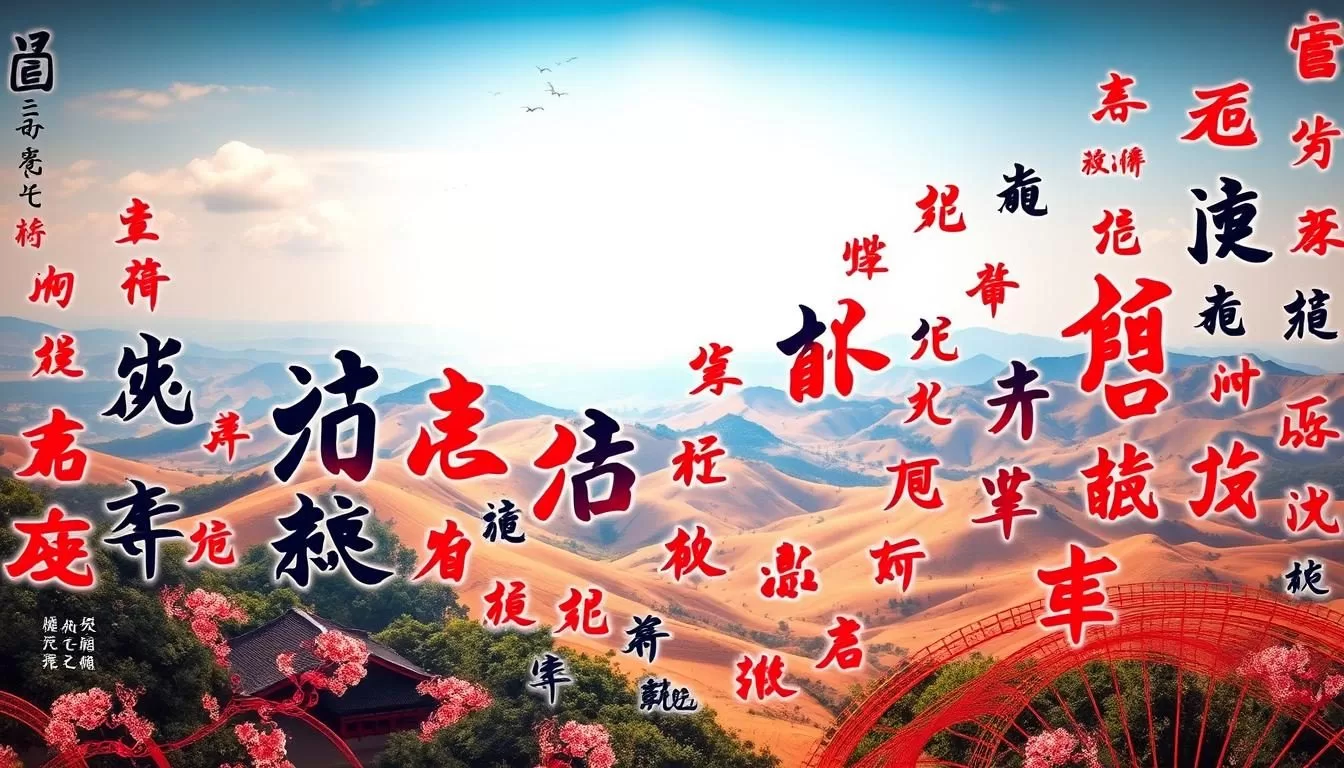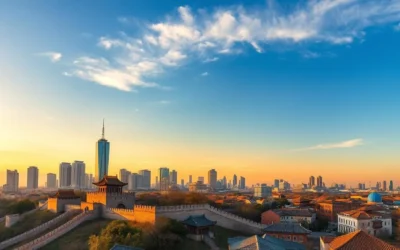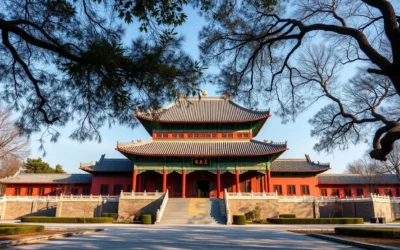✓ Accommodations ✓ Flights ✓ Rental Cars
When you think about communication, the Chinese language often comes to mind as one of the most widely used in the world. In certain areas, this linguistic landscape becomes even more fascinating. Here, you’ll discover how Mandarin Chinese serves as the official language, connecting people across diverse communities.
This region is home to a rich tapestry of dialects and minority tongues. While Mandarin unites many, other languages thrive, reflecting the area’s cultural depth. Over 70% of individuals in mainland China speak Mandarin, making it a cornerstone of daily life.
Understanding this linguistic diversity helps you appreciate the region’s unique identity. Whether you’re a traveler or a language enthusiast, this exploration offers valuable insights into how language shapes communities.
Introduction to Qinghai’s Linguistic Heritage
Exploring the linguistic heritage of this region reveals a fascinating blend of cultures. The population here speaks a rich array of languages and dialects, reflecting its deep cultural roots. This diversity is shaped by the many ethnic groups that call this area home.
Geographical features, particularly the mountainous terrain, play a significant role in shaping these linguistic differences. In isolated areas, unique dialects have developed over time. This makes the region a treasure trove for language enthusiasts.
Key figures highlight the spread of languages across this area. For example, the Tibetan people form the largest ethnic group, contributing significantly to the linguistic landscape. This background sets the stage for understanding the historical development of languages here.
Historical Roots and Language Development in Qinghai
The roots of communication in this area stretch back to ancient times. Over the centuries, dynastic eras and cultural exchanges have shaped the linguistic landscape. This region’s unique geography, with its mountainous terrain, has also played a significant role in language development.

Ancient Origins and Cultural Influences
Early language families in this region were influenced by migration and cultural interactions. The Ming dynasty, for example, brought Chinese colonists who interacted with local groups like the Monguor and Tibetan people. This blending of cultures led to the emergence of unique dialects.
Mountainous areas acted as natural barriers, allowing distinct language groups to develop in isolation. Over time, these dialects became a vital part of the region’s identity. Today, many speakers continue to use these languages at home, preserving their heritage.
Evolution Through Dynasties
Language evolution here was shaped by historical events. During the Ming dynasty, the establishment of military colonies introduced new linguistic elements. These colonies became hubs for cultural exchange, fostering the growth of hybrid dialects.
By the 15th century, the region had become a melting pot of language families. Tibetan, Mongolic, and Turkic influences blended with Chinese, creating a rich linguistic tapestry. This diversity remains a defining feature of the area today.
Qinghai Province, China: Official and widely spoken languages
Understanding the linguistic framework of this region reveals a blend of tradition and modernity. The official language here is Standard Mandarin, which serves as a unifying force across diverse communities. Over 70% of the population in mainland China can speak this language, making it a cornerstone of daily communication.
In public and cultural texts, the writing system primarily uses Chinese characters. These characters are deeply rooted in history and remain a vital part of the region’s identity. Modern adaptations of these characters are also used in official documents, reflecting a balance between tradition and practicality.
Standard Mandarin functions alongside local vernacular forms in daily life. In certain areas, influences from Hong Kong and Macau are evident, particularly in the use of traditional characters. This blend of linguistic practices highlights the region’s cultural diversity.
The role of language extends beyond communication; it serves as a cultural marker. In some parts, local dialects are preserved and used at home, ensuring the continuity of heritage. This practice is especially common in rural regions where traditional ways of life remain strong.
| Writing System | Usage | Influences |
|---|---|---|
| Chinese Characters | Official documents, public texts | Traditional and modern adaptations |
| Local Dialects | Daily communication, cultural preservation | Ethnic and regional influences |
| Standard Mandarin | Unified communication, education | National language policy |
This linguistic landscape showcases how language shapes both cultural identity and official communication. Whether you’re exploring urban centers or rural villages, the interplay of tradition and modernity is evident in every conversation.
The Official Language Policy and Its Regional Impact
Language policies play a crucial role in shaping how communities communicate and preserve their heritage. In this region, the language policy balances the promotion of Mandarin Chinese with the protection of minority tongues. This dual approach ensures unity while respecting cultural diversity.
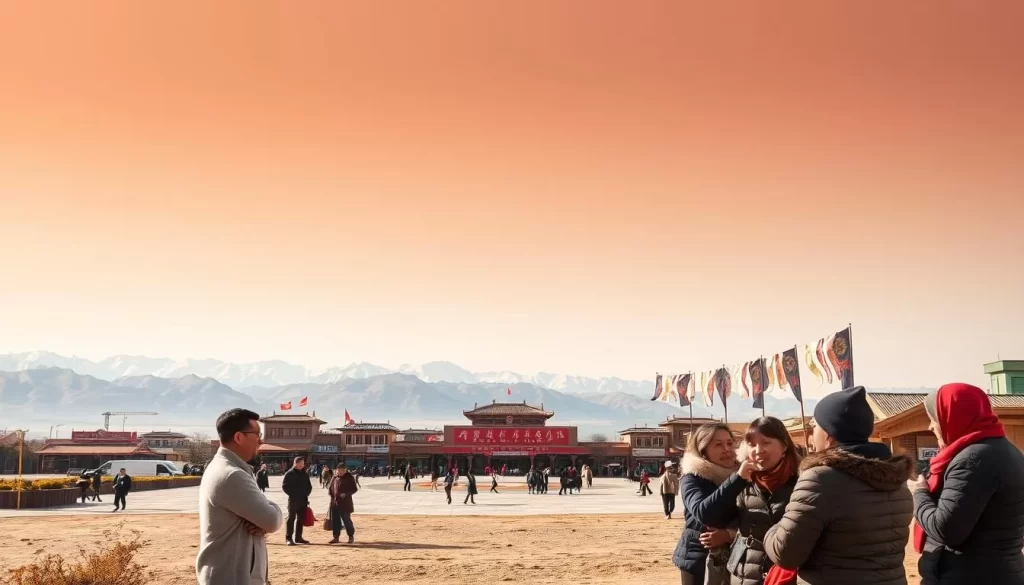
Mandarin Promotion and Minority Language Rights
Efforts to promote Mandarin Chinese have been significant, especially in education and media. Starting from third grade, students must use the national curriculum, which is taught in Mandarin. This policy aims to create a unified communication system across the region.
However, minority languages are also given space in certain contexts. For example, local dialects are often used at home, preserving cultural identity. Despite this, challenges like lack of funding and qualified teachers hinder minority language education.
Policy Changes Over the Century
The evolution of language policy reflects broader historical shifts. During the Qing Dynasty, the Resolution on Methods of National Language Standardization marked a turning point. Later, the People’s Republic adopted a Soviet model of multinational state building, influencing language education policies.
Today, the focus is on balancing national unity with cultural diversity. The Law on the National Standard and Spoken Language, adopted in 2000, made Mandarin a right, further shaping the linguistic landscape. These changes highlight the ongoing effort to adapt policies to modern needs.
Understanding these policies helps you see how they impact everyday life. From education to public administration, the system ensures that language remains a tool for both unity and cultural preservation.
The Role of Mandarin Chinese in Qinghai’s Communication Landscape
Communication in this region thrives on a mix of formal and informal language practices. Mandarin Chinese serves as the backbone of daily interactions, bridging diverse communities. Its role extends beyond casual conversations, influencing business and cultural exchanges.
Standard Mandarin vs. Local Variants
While Standard Mandarin is the national language, local dialects add richness to the linguistic landscape. Variants like plains Mandarin are commonly used in rural areas, reflecting regional identity. This coexistence highlights the balance between unity and diversity.
In urban centers, Standard Mandarin dominates formal settings like education and governance. However, at home, many families prefer local dialects, preserving their cultural heritage. This dual usage ensures that both tradition and modernity thrive.
Influence on Daily and Business Communication
In the business world, Mandarin Chinese is essential for seamless communication. It connects professionals across regions, fostering collaboration and growth. This linguistic unity is particularly vital in trade and commerce.
Daily interactions also reflect the influence of Mandarin. Whether in markets or social gatherings, it serves as a common thread. This widespread use strengthens community bonds, making it a cornerstone of regional identity.
Minority Languages and Dialect Diversity in Qinghai
The linguistic diversity of this region is a testament to its rich cultural heritage. Here, you’ll find a tapestry of minority languages and dialects, each reflecting the identity of its ethnic group. Among these, Amdo Tibetan stands out as a prominent tongue, spoken by around 6 million people.
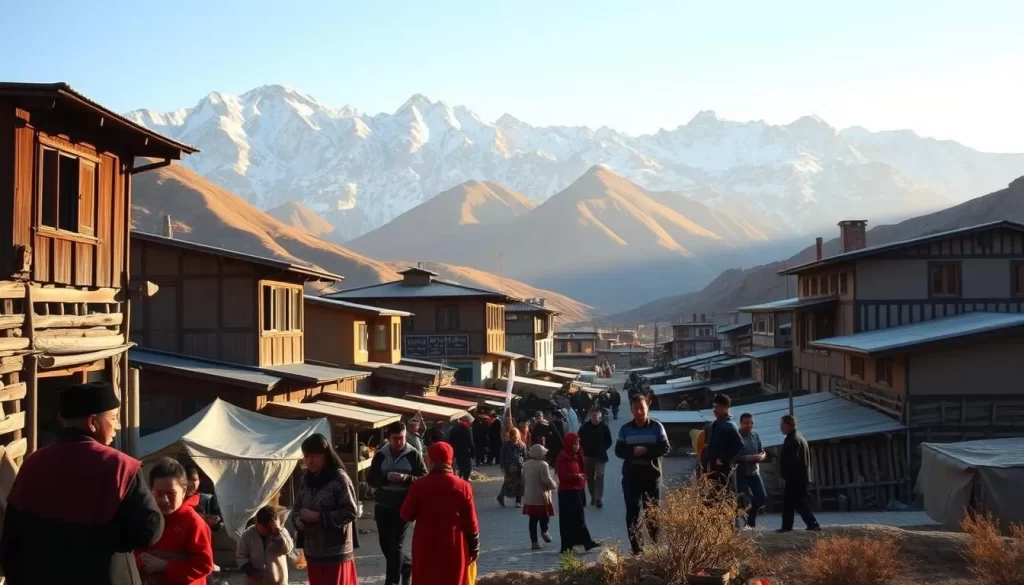
Amdo Tibetan and Other Regional Tongues
Amdo Tibetan is one of the most widely spoken minority languages in the area. It belongs to the language family of Tibeto-Burman, which has deep historical roots. This dialect is not just a means of communication but a vital part of cultural identity for many groups.
Other regional tongues, such as Mongolian and Uighur, also play a significant role. These languages are often used at home, preserving traditions and fostering a sense of belonging. For many persons, these dialects are a bridge to their heritage.
The Impact of Ethnic Diversity on Language Use
Ethnic diversity shapes how languages are used in daily life. In rural areas, local dialects dominate, while urban centers see a blend of Chinese language and minority tongues. This dual usage highlights the balance between tradition and modernity.
For example, in schools, Mandarin Chinese is the primary medium of instruction. However, at home, many families continue to speak their native dialects. This practice ensures that cultural identity is passed down through generations.
| Language | Region | Speakers |
|---|---|---|
| Amdo Tibetan | Tibetan Plateau | 6 million |
| Mongolian | Inner Mongolia | 5 million |
| Uighur | Xinjiang | 10 million |
This linguistic landscape showcases the interplay between official language promotion and local language retention. Whether in rural villages or bustling cities, the richness of dialects adds depth to the region’s cultural fabric.
Writing Systems and Orthographic Traditions
The way people write and read in this region tells a story of cultural richness and diversity. Writing systems here are more than just tools for communication—they are cultural touchstones that reflect the identity of their speakers. From traditional Chinese characters to minority scripts, each system carries a unique history and significance.
Chinese Characters and Local Adaptations
Chinese characters are a cornerstone of the writing system in this area. These characters, deeply rooted in history, have evolved over centuries to meet modern needs. For example, the Xixia writing system, developed between the 11th and 13th centuries, was based on the Chinese model.
Local adaptations of these characters have also emerged. Pictographic systems influenced by Chinese writing have been developed by tribes like Yi and Naxi within the last 500 years. These adaptations highlight the creativity and resilience of local cultures.
Non-Sinitic Scripts in Minority Communities
Minority communities in this region use a variety of non-Sinitic scripts to preserve their language spoken traditions. For instance, the Tibetan writing system dates back to the 7th century and remains a vital part of cultural identity.
Other scripts, like those used by the Monguor and Uighur people, also play a significant role. These alphabets are not just tools for communication but symbols of heritage and pride. They ensure that minority languages continue to thrive in a rapidly changing world.
Understanding these writing systems gives you a deeper appreciation of the region’s cultural diversity. Whether you’re exploring traditional Chinese characters or minority scripts, each system offers a glimpse into the rich tapestry of this area. For more insights into the origins of these systems, check out this detailed exploration of the Chinese writing system.
The Intersection of Language and Culture in Qinghai
Every dialect tells a story, reflecting the heart of a community’s heritage. In this region, the way people speak is deeply tied to their cultural identity. Whether in rural villages or bustling towns, spoken language serves as a bridge to the past.
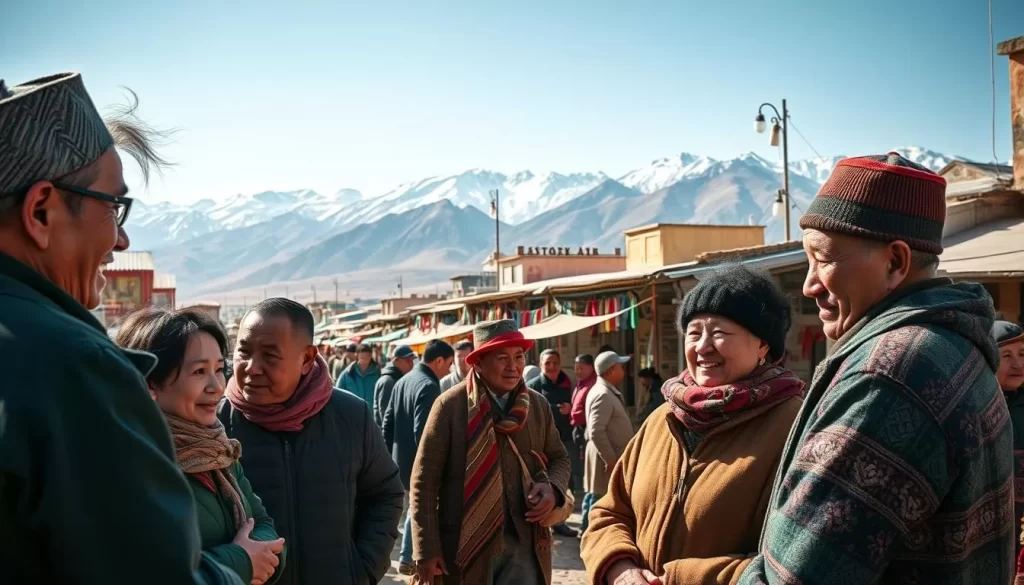
Daily life here is shaped by the rhythms of local dialects. From morning greetings to evening stories, these linguistic forms connect people to their roots. For many, using a dialect at home is a way to preserve traditions and pass them to the next generation.
Cultural practices, such as festivals and rituals, often incorporate spoken language in unique ways. These events highlight the richness of local dialects, showcasing their role in storytelling and community bonding. Media outlets also play a part, with articles and programs dedicated to preserving language diversity.
Understanding this connection between language and culture helps you appreciate the region’s unique identity. Whether you’re exploring traditional customs or modern media, the interplay of dialects and daily life is evident.
Economic Influences and Language in Business
In the world of trade and commerce, language acts as a bridge connecting diverse communities. It’s not just about words; it’s about understanding cultures, building trust, and driving economic growth. Across borders and regions, effective communication is the backbone of successful business interactions.
Language as a Tool in Trade and Commerce
In this region, Mandarin Chinese plays a pivotal role in trade. Over 70% of the population in mainland China speaks Mandarin, making it the go-to language for negotiations and partnerships. Whether you’re dealing with local vendors or international clients, fluency in Mandarin can open doors to new opportunities.
Standardized characters in official documents ensure clarity and consistency. This is especially important in cross-border transactions, where misunderstandings can lead to costly errors. The use of Pinyin, a romanization system, further simplifies communication for non-native speakers.
Community and Business Communication
In urban centers, Mandarin dominates business settings, while local dialects thrive in community interactions. This dual usage reflects the balance between tradition and modernity. For example, in the central plains, plains Mandarin is commonly used in daily transactions.
Here are some strategies for effective communication in this area:
- Learn basic phrases in local dialects to build rapport.
- Use standardized characters in contracts to avoid confusion.
- Leverage technology like translation apps for seamless interactions.
Understanding the language spoken in this region not only enhances business prospects but also fosters cultural appreciation. For more insights into the diversity of the Chinese language, explore this detailed resource.
Education, Media, and Language Preservation Initiatives
Efforts to preserve linguistic diversity are shaping education and media in meaningful ways. Bilingual education programs and media representation play a crucial role in safeguarding minority languages. These initiatives ensure that cultural heritage remains alive for future generations.
Bilingual Education Efforts
Bilingual education has become a cornerstone of language preservation. Since 2010, China introduced a policy promoting bilingual education in minority areas. This approach balances the use of Mandarin with local dialects, helping students maintain their cultural identity while gaining proficiency in the national language.
In urban areas, primary schools began teaching Mandarin from Grade 1, replacing the previous Grade 3 start. This shift has increased the number of teachers using Mandarin for instruction, tripling over a 12-year period. However, challenges like teacher shortages and funding gaps remain, particularly in rural regions.
Curriculum and Media Representation
Curriculum changes are helping preserve local dialects and languages. By 2017, bilingual education was universalized at the preschool level, impacting over 81,000 children. This early exposure ensures that young learners develop proficiency in both their native tongue and Mandarin.
Media also plays a vital role in cultural preservation. Programs and articles dedicated to minority languages highlight their importance in daily life. For example, Tibetan-language media helps bridge the gap between urban and rural communities, fostering a sense of unity.
These initiatives not only enhance language proficiency but also strengthen cultural identity. To learn more about the role of education in preserving cultural heritage, explore this detailed study.
Cross-Border Linguistic Exchanges and Regional Identity
Language bridges borders, creating connections that shape regional identities. In this area, interactions with neighboring regions have fostered a unique blend of spoken language and cultural practices. These exchanges not only enrich communication but also strengthen the sense of belonging among the population.
Influences from Neighboring Regions
Neighboring areas like Hong Kong have significantly impacted the linguistic trends here. The flow of people and ideas across the border has introduced new vocabulary and expressions. For example, the use of foreign language phrases in daily conversations reflects this cultural exchange.
Historical ties also play a role. The Tang dynasty’s military campaigns led to significant population movements, influencing the development of local dialects. Today, these dialects continue to evolve, blending traditional elements with modern influences.
Personal interactions further shape cross-border language use. Whether through trade or travel, individuals bring their linguistic heritage, enriching the region’s cultural fabric. This dynamic exchange ensures that language china remains a living, evolving entity.
For a deeper understanding of these linguistic interactions, explore this detailed study on the Tangwang language and its cultural significance.
The Future of Language and Cultural Preservation in Qinghai
Looking ahead, the preservation of linguistic diversity remains a key focus in this region. Efforts to protect minority languages are gaining momentum, ensuring that cultural heritage thrives for future generations. With language policy reforms on the horizon, the balance between unity and diversity is set to evolve.
Efforts to Preserve Minority Languages
Initiatives to safeguard minority languages are becoming more robust. Bilingual education programs, for instance, are expanding to include local dialects alongside central plains Mandarin. This approach helps students maintain their cultural identity while mastering the official language.
Digital technology is also playing a pivotal role. Platforms like e-commerce and mobile payments are creating economic opportunities for local artisans, while preserving traditional practices. However, disparities in internet access remain a challenge, particularly for older individuals and those in remote areas.
Anticipated Policy Reforms and Trends
Future policy reforms aim to strengthen minority language education. The central government has pledged to reform examination systems, ensuring proficiency in Mandarin while safeguarding the right to learn native tongues. This dual approach reflects a commitment to both unity and cultural diversity.
Historical legacies, such as the influence of the dynasty era, continue to shape language development. Over the next century, trends in alphabet usage and writing systems are expected to enhance official language standards. These changes will likely bridge the gap between tradition and modernity.
For more insights into these initiatives, explore this detailed resource on cultural preservation efforts.
Conclusion
Language is a powerful tool that shapes how we connect and understand the world around us. In this region, the blend of Mandarin Chinese and local dialects creates a unique linguistic landscape. From daily conversations at home to formal settings, this diversity reflects the area’s rich cultural identity.
Over 70% of the population in mainland China speaks Mandarin, making it a cornerstone of communication. Yet, local dialects like Amdo Tibetan and Mongolic languages thrive, preserving heritage in rural and urban areas. This balance between unity and diversity ensures that traditions remain alive while fostering modern connections.
Efforts to maintain this linguistic mosaic are crucial for future generations. Bilingual education and media representation play key roles in safeguarding minority languages. For those interested in exploring this further, check out this detailed study on endangered Sinitic languages.
As you reflect on this linguistic journey, remember how language connects us to our roots and shapes our shared future. Whether through characters or spoken words, it’s a bridge to understanding and preserving our world.
The above is subject to change.
Check back often to TRAVEL.COM for the latest travel tips and deals.
